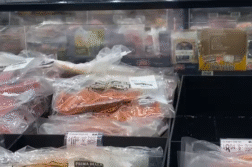COLUMBUS, Ohio (Ivanhoe Newswire)— As the number of new COVID infections in the U.S. continues to go down, scientists are turning their attention to learning more about the origin of the virus, which some believe was a bat. Researchers are also studying COVID in other animals and the environment to identify the potential source of future pandemic threats. Animals spreading COVID
A tiger at a New York Zoo. Gorillas in San Diego. And a handful of companion pets, like cats and dogs, have all tested positive for the COVID virus.
“We know that this virus can jump species and what we want to know next, or be able to tell as early as possible, is what other species can it be in?” questioned Vanessa Hale, PhD, The Ohio State University College of Veterinary Medicine.
Hale and a team of microbiologists and other scientists are part of eScout. The goal is to identify the virus in different animals and determine if those animals are harboring mutations that could spread COVID back to humans.
“We’re testing deer squirrels, mink, rabbits and working closely with a lot of different community members, including other veterinarians and veterinary clinics to test things like ferrets as well. We’re also testing pigs at agricultural fairs. So, state and county fairs where pigs may be coming together for shows,” continued Hale.
The scientists are also monitoring wastewater and urban runoff for the Sars-Cov-2 virus to determine what strain of the virus is circulating. Researchers say environmental surveillance will be important in long-term COVID prevention measures.
Professor Hale says scientists have found that the rates of animal transmission are very low with the exception of minks—which are in the same family as otters and weasels. Hale says COVID seems to transmit more easily from minks to people, and from people back to minks.
Contributors to this news report include: Cyndy McGrath, Executive Producer; Kirk Manson, Videographer; Bob Walko, Editor.
To receive a free weekly e-mail on medical breakthroughs from Ivanhoe, sign up at: http://www.ivanhoe.com/ftk
Source:
https://www.cdc.gov/coronavirus/2019-ncov/daily-life-coping/animals.html
MEDICAL BREAKTHROUGHS
RESEARCH SUMMARY
TOPIC: ANIMALS SPREADING COVID?
REPORT: MB #4925
BACKGROUND: SARS-CoV-2 stands for severe acute respiratory syndrome coronavirus 2. It is a virus that causes respiratory illness in humans. This virus spread rapidly throughout the world, passengers on cruise ships, and people in skiing resorts and other places. As of March 2021, it has caused a global pandemic with approximately 117 million confirmed cases and 2.6 million deaths worldwide. This virus also was also reportedly passed from animals to humans in Wuhan, China and was first reported in December 2019.
(Source: https://www.news-medical.net/health/The-Naming-System-Behind-SARS-CoV-2.aspx)
DIAGNOSING: Current diagnostic tests for the SARS-CoV-2 pandemic use nucleic acid, antibody and protein-based detections, but viral nucleic acid detection by RT–PCR remains the primary standard to detect it. Nucleic acid tests have improved sensitivity and specificity for viral detection over the now available serological tests. The recognition of SARS-CoV-2 over common respiratory pathogens is contingent on RT–PCR serving as a sensitive, precise and specific viral detection. Despite the test’s accuracy, results have not yet enabled the containment of viral infection. In February 2020, the US Food and Drug Administration (FDA) permitted licensed laboratories to report in-house SARS-CoV-2 diagnostic tests.
(Source: https://www.nature.com/articles/s41563-020-00906-z)
NEW TECHNOLOGY: Vanessa Hale, assistant professor for the Ohio State University College of Veterinary Medicine and a team called ‘e-Scout, Environmental-First Surveillance for COVID-19 in Ohio, Understanding Transmission” is looking at the environment around Ohio to detect SARS-COV-2. They are also looking at animal health and testing them to see any indications of the virus. The team is also looking at the waterways. Identifying the virus in wastewater can help determine how much and what strain of virus is circulating within a population. Viral spikes in wastewater also allow early detection of outbreaks. Environmental surveillance has been used in the past to identify other things such as the flu. It’s likely that this same kind of surveillance will play a critical role in discovering sources of SARS-COV-2.
FOR MORE INFORMATION ON THIS REPORT, PLEASE CONTACT:
TONI HARE
If this story or any other Ivanhoe story has impacted your life or prompted you or someone you know to seek or change treatments, please let us know by contacting Marjorie Bekaert Thomas at mthomas@ivanhoe.com




